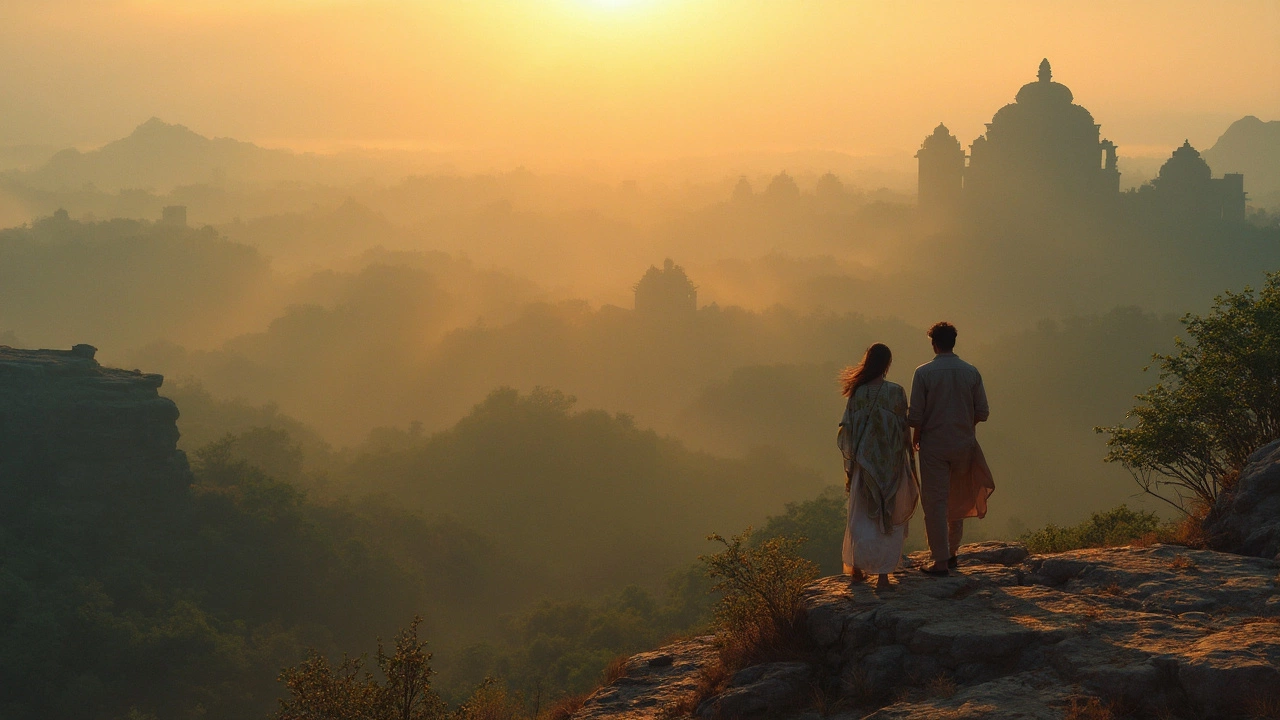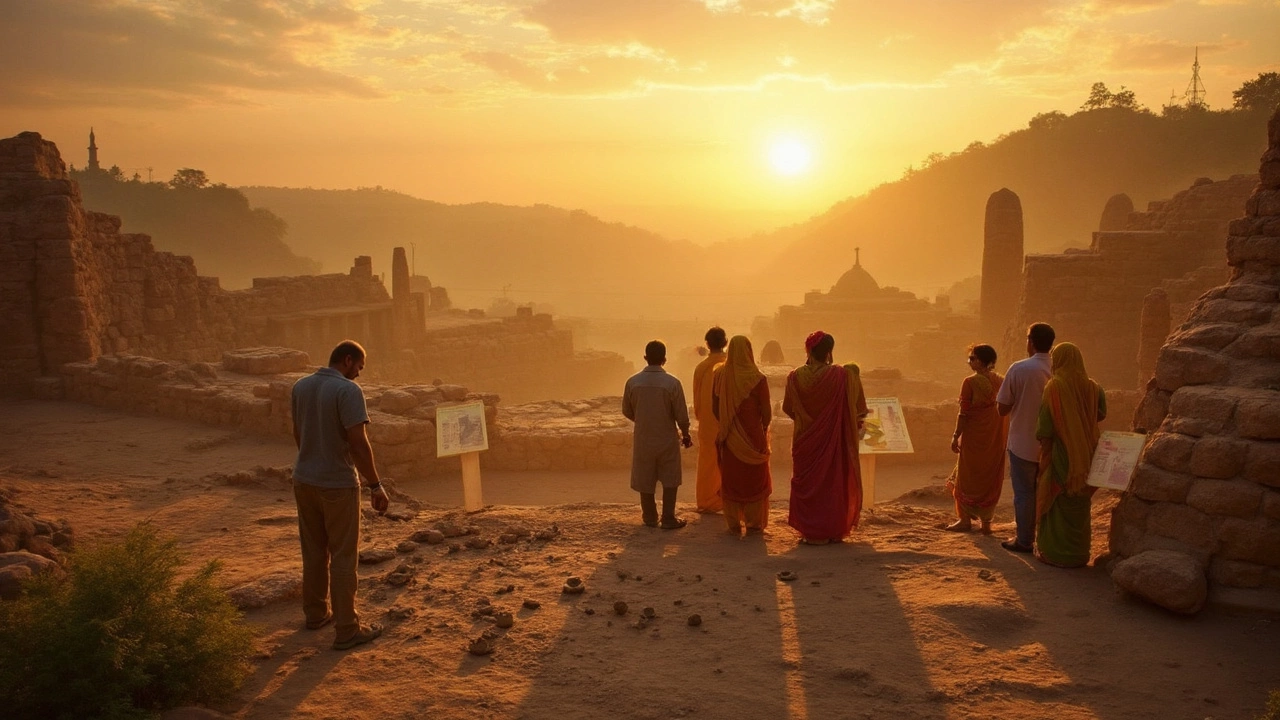Ever wondered where you can time travel? India's got just the ticket with its mesmerizing ancient sites. You won't need a flux capacitor for this journey—simply a curious mind and maybe a good pair of walking shoes.
Among the many treasures that India holds, Mohenjo-Daro often takes the spotlight. Known as one of the world's earliest urban settlements, it still amazes archaeologists and history buffs alike. Imagine wandering through streets that people walked thousands of years ago—it’s like stepping into a history book.
Wondering what makes these places matter? Each site isn't just a bunch of old stones; they’re living stories showcasing art, architecture, and human creativity from ages past. These relics are reminders of who we were and, in a way, who we are today.
Unveiling Ancient Wonders
When you think of ancient places in India, Mohenjo-Daro might jump to mind. Located some 600 kilometers southwest of Islamabad, even though it's now in present-day Pakistan, it was part of the ancient Indus Valley Civilization. This site dates back to around 2500 BCE, showcasing an advanced urban architecture unseen in many other places of that era.
The Ruins of Mohenjo-Daro
The city had a complex drainage system and impressive buildings that suggest a high degree of planning. Picture wide streets laid out in perfect grid patterns and public baths that rival modern facilities. These reflect the technological advances of this early civilization and remind us of how progressive society was thousands of years ago.
Don't just take my word for it—UNESCO declared it a World Heritage Site in 1980, recognizing its value in human history. The site still astounds with artifacts like pottery, jewelry, and even toys, lending insight into the daily lives of its people.
Unexplored Marvels Around India
India’s ancient wonders aren’t just limited to one spot. In the heart of the country lies Hampi, another UNESCO World Heritage Site. Established in the 14th century, it was once the capital of the Vijayanagara Empire. It's a place where giant boulders balance precariously on each other, surrounded by stunning temples and monuments that tell stories from Hindu mythology.
The architecture here is grand, with the famous Virupaksha Temple being a must-see. It’s still in operation today, and let’s just say the carvings can leave you speechless. For a real treat, visit during the annual Hampi festival when the site comes alive with music and dance, much like it did centuries ago.
Notable Facts at a Glance
| Site | Approximate Era | Unique Feature |
|---|---|---|
| Mohenjo-Daro | 2500 BCE | Advanced drainage system |
| Hampi | 14th century | Giant boulders and intricate temples |
Exploring these ancient places is like flipping through the pages of a real-life history book. Each site tells us not just where we've been but perhaps where we might be going. Get ready to be amazed, because the past has a lot to share with us today.
Why It Matters
Why should we care about ancient places in India? Simple. These sites are the closest things we have to a time machine. They offer glimpses into civilizations that laid the groundwork for the world as we know it. Each brick, mural, and artifact tells a part of a grand story of human achievement and resilience.
Take the ruins of Mohenjo-Daro. This ancient city dates back to around 2500 BCE and it wasn't just any city—it showcased sophisticated urban planning that would put some modern cities to shame. They had advanced drainage systems, public baths, and even grid-style streets. You might be wondering, why should we be bothered by some old ruins? Well, these structures are templates, showing us how intelligence and resourcefulness can create civilizations that thrive.
"These ancient sites are not merely piles of stones. They are the enduring evidence of the societal, philosophical, and architectural ingenuity of our ancestors." - Dr. Irfan Habib, historian and author
Understanding Indian history through these places provides insights into cultural and technological advancements. They are crucial for archaeologists who piece together human history and for students who want to see where earlier giants once tread.
Why else do they matter? They shape identity. These heritage sites in India are part of what defines the country. They connect people to a shared past and foster national pride. It's like finding an old family photo album that lets you see where you came from.
Besides, these places are economic boosts as well. Tourism around these sites brings in millions, providing jobs and reviving local economies. So, when you visit an ancient site, you're not just time-traveling; you're helping sustain communities.

Travel Tips
Traveling to ancient places in India is like opening a time capsule. But to make the most of your trip, a little planning goes a long way. Here's how you can make history come alive during your visit.
Best Time to Visit
If you're heading to heritage sites in India, consider planning your visit during the cooler months, from November to February. Trust me, exploring ancient ruins in sweltering heat isn't as fun as it sounds. Plus, the weather's perfect for those Insta-worthy shots.
What to Pack
Pack light but smart. Comfortable clothing and sturdy walking shoes are a must. Don't forget sunscreen and a hat to protect from the sun. A good camera and a reusable water bottle will also be your best travel buddies.
Getting Around
Local transportation can be a bit chaotic, but it's part of the charm. Trains and buses are affordable and give you a taste of local life. If you're short on time, hiring a cab or using ride-sharing apps can be convenient. Just keep an eye on those fares!
Understanding Local Customs
India is as diverse as its ancient sites. Respecting local customs will enrich your experience. Dress modestly, especially when visiting religious sites, and always ask for permission before clicking pictures of people. A little respect goes a long way.
Staying Safe
While India is generally safe, keeping an eye on your belongings is always a good idea. Be cautious of any too-good-to-be-true deals. Most importantly, stay hydrated and stick to bottled water to avoid tummy troubles.
With these tips, you're all set to dive into the depths of history and make your trip an unforgettable journey through time.
Fun Facts
When exploring ancient places in India, you're bound to stumble upon some quirky and fascinating nuggets of history. These aren't just dusty old tales; they’re captivating stories worth sharing.
1. Mohenjo-Daro's Urban Planning
Did you know that Mohenjo-Daro had an incredibly advanced urban design for its time? We're talking about a well-planned grid layout, sophisticated drainage systems, and even public baths. That's right, ancient plumbing before it was cool!
2. Hampi's Musical Pillars
Ever heard of musical stones? Hampi, one of the notable heritage sites in India, boasts the Vitthala Temple with 56 musical pillars. Tap lightly, and they produce a variety of musical sounds—a rock concert, literally!
3. Varieties of Languages
In some of these sites, ancient scripts like Brahmi or Kharosthi have been found, offering insights into the languages and dialects of the time. It's amazing how these scripts act like words frozen in stone.
4. Wildlife and History Combo
Interestingly, the Gir Forest near the ancient city of Dwarka isn’t just known for its history but also for being the last refuge of the Asiatic Lion. It's like uncovering two different worlds at once.
| Site | Known For | Unique Feature |
|---|---|---|
| Mohenjo-Daro | Urban Planning | Drainage System |
| Hampi | Temples | Musical Pillars |
| Dwarka | History | Proximity to Gir Forest |
These bits and pieces of information show how these ancient sites are more than just relics of the past. They're packed with stories and features that continue to amaze us today.
